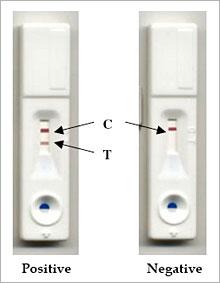Part I: 5 signs that you are pregnant
When Divya Mani, a 24-year old accountant from Mumbai, missed her period, she figured she may be pregnant. Divya knew about home pregnancy tests. But did she take one? No. Instead, she made an appointment with an obstetrician.
"I was not sure if I could really do the test at home, so I decided to see the doctor anyway. But the first thing the doctor did at the clinic was perform the urine pregnancy test. And it looked so simple." she says.
Divya is one among many educated women who did not take advantage of the convenience of this test. The reason: they are unsure of the details.
If you miss a period and want to quickly check if you are pregnant, before you visit your doctor, try the home pregnancy test. This is is especially convenient for women who are trying to get pregnant. After all, you do not want to go rushing to a doctor each time you experience some telltale sign of pregnancy but are not sure you are pregnant.
How does it work?
The home pregnancy test works by detecting a hormone called Human Chorionic Gonadotropin (hCG) in your urine. This hormone appears in a pregnant woman's urine, approximately 20 days after her last menstrual period. The levels then rise rapidly, reaching a peak in the next 60 to 80 days.
How is the test performed?
Try to perform the test first thing in the morning for optimal results, though this is not mandatory.
- Pregnancy tests are usually stored in the refrigerator. So, make sure you bring the test kit to room temperature before you use it.
- Collect urine in a clean, dry glass or plastic container. Ensure that there is no detergent residue in the container.
- Take out the pregcolor card (see image below) and place it on a flat surface.
- Draw out a little urine with a dropper (provided with the kit) and put just two drops in the circular test well that is usually marked 'S'. Do not spill urine on the reading strip.
- Wait for three to five minutes (depending on manufacturer's instructions) and then read the test results. Trying to read the results before the stipulated time or waiting too long, can both lead to inaccurate readings.
Some newly launched pregnancy test kits (for example, Clearview) can be held directly in the urine stream and do not require you to collect urine in a container. These kits are usually more expensive (around Rs 150).
 How do I interpret the results?
How do I interpret the results?
1. Look at the regions marked 'C' and 'T' on the test card. 'C' indicates a control. This band must always appear because this is the comparison band. 'T' indicates the test sample.
2. If only one pink/purple band appear, in the region marked 'C', it means that the test is negative for pregnancy.
3. If two pink/purple bands appear, one in the region marked 'C' and the other in the region marked 'T', it means that the test is positive for pregnancy
4. In case no bands appear, then the test is invalid. Repeat the test with a new pack of pregcolor cards after 72 hours.
5. If the line formed in region 'T' is faint, this could be due to low levels of hCG hormone. In case of a faint band, repeat the test with a new pack of pregcolor cards after 72 hours.
Will the test work if I have just missed my period?
In most cases, the test is sensitive enough to detect pregnancy even on the day of the missed period. In some women though, the levels of hCG are not detectable so early in the pregnancy. If the test is negative, you might want to try and repeat it after 72 hours.
It is, in fact, advisable to wait a couple of days to a week after missing your period, before you perform the test. This will help avoid a falsely negative test.
Can the test be falsely positive?
Though very rare, this could happen. Certain drugs, especially drugs used for treatment of infertility, including hCG shots might cause the test to be falsely positive. So could an ectopic pregnancy (when the foetus is implanted in an area other than the uterus like the Fallopian tubes or the cervix), though technically it is a pregnancy.
Pain medication, oral contraceptives, antibiotics, etc, usually do not affect the test results.
What if the test is negative?
If the test is negative the first time you perform it, wait for 72 hours and repeat the test. The first negative result might be because the test was taken too early and the hormone levels had not risen enough to be detected. On the other hand, it could be because of faulty technique. Follow the instructions carefully when you repeat the test.
Dr Anjali Rajurkar, an obstetrician from Mumbai, says, "If you are experiencing other symptoms of pregnancy and yet your test turns out negative twice, see your obstetrician immediately. "
What kinds of home pregnancy tests are available in the market and where do I buy them?
In addition to Clearview, the other kits available are Pregcolor Card, Pregtest Card and Veklocit. The average cost per kit is around Rs 50.
Home pregnancy tests are usually available at most chemist/medical shops.
What should I do if the test is positive?
If the test is positive do a test at your nearest lab and then visit your obstetrician to confirm the pregnancy and get further medical advice.
Part I: 5 signs that you are pregnant
-- The author has an MBBS from KEM Hospital, Mumbai, with a Masters in Nutrition from the University of Texas at Austin.








More from rediff